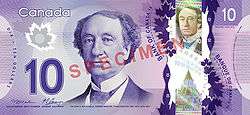Canadian ten-dollar note
| (Canada) | |
|---|---|
| Value | 10 Canadian dollars |
| Width | 152.4 mm |
| Height | 69.85 mm |
| Security features | Holographic stripe, Watermark, EURion constellation, Tactile marks, Registration device, Raised printing, UV printing |
| Paper type | Polymer |
| Years of printing | 2001–present |
| Obverse | |
 | |
| Design | Sir John A. Macdonald |
| Designer | Bruce Stewart |
| Design date |
2001 2005 |
| Reverse | |
 | |
| Design | Via Rail route map, featuring The Canadian. In the background; the Canadian Rockies |
| Designer | Bruce Stewart |
| Design date |
2001 2005 |
The Canadian ten-dollar note is one of the most common banknotes of the Canadian dollar.
The current ten-dollar note is dominantly purple in colour. The front features a portrait of Canada's first Prime Minister Sir John A. Macdonald, and a metallic image of the Library of Parliament. The reverse side shows Via Rail's train, The Canadian, with the Rocky Mountains in the background; this is accompanied by a map of the Canadian Railways. Yellow dots representing the EURion constellation can be found on both sides. As well as textured printing, this design includes Braille dots for the blind indicating the denomination as a new tactile feature.
An updated version of the note began circulation on May 18, 2005, with new security features. On the front, these include a holographic stripe along the left side, depicting the number 10 alternated with maple leaves; a watermark of Macdonald's portrait; and a broken-up number 10, which resolves itself when backlit (the latter two which replaced the shiny-leaf feature). On the back, it has an interleaved metallic strip, reading '10 CAN' repeatedly along its length.
The version of the note issued in 1971 depicted the operations of Polymer Corporation on its back.
Less-visible security features include ultraviolet-detected threads in the paper, as well as an ink imprint of the coat of arms.
As with all modern Canadian banknotes, all text is in both English and French.
A new ten-dollar note made with polymer, as part of the "Frontier Series", was released on November 7, 2013. The new note features a new portrait of Sir John A. Macdonald and hologram of the Library of Parliament on the front and the Canadian (Via Rail train pulled using F40PH-2 locomotive) in the Rockies on the back.[1] After mistakenly identifying Mount Edith Cavell and Mount Marmot as appearing in the background, the Bank of Canada later corrected them as Lectern Peak, Aquila Mountain, Mount Zengel and other mountains.[2]
| Series | Main colour | Obverse | Reverse | Series Year | Issued | Withdrawn |
|---|---|---|---|---|---|---|
| 1935 Series | Purple | Mary, Princess Royal and Countess of Harewood | Harvest allegory | 1935 | 11 March 1935 | |
| 1937 Series | Purple | George VI | Transportation allegory | 1937 | 19 July 1937 | |
| 1954 Series | Purple | Elizabeth II | Mount Burgess, British Columbia | 1954 | 9 September 1954 | |
| Scenes of Canada | Purple | John A. Macdonald | Polymer Corporation oil refinery in Sarnia, Ontario | 1971 | 8 November 1971 | 27 June 1989 |
| Birds of Canada | Purple | John A. Macdonald | Osprey | 1989 | 27 June 1989 | 17 January 2001 |
| Canadian Journey Series | Purple | John A. Macdonald | Peacekeeping forces and war memorial; poppy field and excerpt from "In Flanders Fields" by John McCrae | 2001 | 17 January 2001 | 18 May 2005 |
| 2004A/2006/2008 | 18 May 2005 | 7 November 2013 | ||||
| Frontier Series | Purple | John A. Macdonald | The Canadian passenger train | 2013 | 7 November 2013 |
References
- ↑ "$10 design" (PDF). Bank of Canada.
- ↑ Beeby, Dean (July 29, 2014). "Bank of Canada erases mountain ID from $10 bill after questions raised". Ottawa Citizen. Canadian Press.